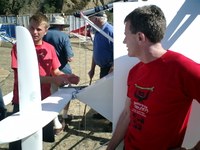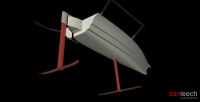Hydrofoil Project
The Canterbury R Class guys have kept an eye on hydrofoil developments for many years, following the various projects with great interest. Almost the entire fleet are completely behind the foil development project and most of the boats plan to put foils on if they are successful.
The foil project is a way to try and get new people into the class, reinvigorate the current fleet and have some fun while we're at it.
Rules and some history
The R Class rules are really pretty simple with no real limits on technology, construction, rig setup, hull shape or foils. One of the intentions of the class founders was to encourage general ongoing development of all elements of the boat.This is nicely summed up by Graham Mander who, in response to Sean asking about hydrofoils basically said "if it makes the boats go quicker, try it".
Rules have changed little over the years, usually by deleting a rule to make the class less restrictive. The last change (in 2004 which removed the E rule), was intended to open up the class and increase development by allowing greater scope in hull design.
The E rule was originally introduced to differentiate the R Class from many flat panel and hard-chine boats around at the time. With construction technology moving on, it was no longer served its purpose and was actually stopping us from building faster boats.
The sail area and one mainsail restrictions have meant that, to maximise performance, we usually use fairly high aspect ratio rigs. Although not as extreme they were prior to 1992, when we increased the working sail area, the ratio is still higher than most other skiffs. R sailors are free to choose the aspect ratio they feel gives them the best all-round performance and sailability.
Over the years many rig configurations have been tried, including wing masts, single windsurfer style rigs, pocket luff, and double surfaced variable thickness aerofoils. The rules were written to be inclusive rather than exclusive of future possibilities. Rule 9.1.1 "The objective is to measure the maximum surface area of the working sails as fairly as possible. If the recommended technique should prove inadequate the measurer shall make appropriate adjustments to achieve this objective".
The rules do not limit the number of foils or constrain foil design in any way, so the development and use of hydrofoils seems entirely consistent with the philosophy and intent of the class.
Previous hydrofoil development

Dan built an adjustable horizontal rudder foil and used it on Liquid in the 2002/2003 season. The boat placed 3rd in the Leander Trophy in 2003. Alex Vallings also briefly experimented with some horizontal wings on his rudder for the 2004 Leander in Auckland. At least on Liquid, any performance gain from the foils seemed to be negated by extra drag downwind. Dan stopped using the T foil when he sold Liquid and then took a year off. Sean was uninterested in using the Tee rudder when they started sailing together, so it was never tried on L3. I'm not aware of any other foil development.
Sailing conditions and design considerations
The harbour where we sail typically has a fairly steady northeast sea breeze that builds to 12 - 15kts by race start around midday. It usually tops out around 20kts, although we do get a good few days of 25 to 30kts with big seas. R rules allow two head sails, two kites and one main with no reefing restrictions. This makes for good coverage through our typical wind-range. Because tides play a role in Lyttelton Harbour, waves can get quite steep on an outgoing tide. Top downwind speeds are often limited by the waves in these conditions.
We get a few strong norwesterly days (NW) during the season, and usually we don't sail in them because of the unpredictable nature and general unpleasantness of launching, retrieving and sailing in the extremely gusty and variable conditions. Due to the shape of the harbour the NW becomes extremely turbulent and often increases in strength with little warning. Southerly (usually SW) conditions are generally pretty nice, apart from launching on the southwest facing ramp, and the harbour stays relatively flat unless the breeze is very fresh.
Its not often that we have conditions under 10kts. So our foiling abilities in marginal conditions and target takeoff windspeed are less of a worry than it would be in other locations.
Final Hurdles Overcome
Andrew Brown and some of the other moth guys brought three Blade Riders down to Lyttelton in March 2008. They generously let us sail them and were very helpful answering our questions. Watching the moths in action alongside the R's in single wiring conditions was inspiring. Seeing in person how easy it is to sail and launch a foiling Moth meant that our last excuse for finally starting a hydrofoil project was no longer legitimate. Upwind the moth was, as expected, very impressive. It was a good bit faster and points much higher. Downwind speed and sailing angle are pretty much the same, although the moth ride is much smoother. We were twin-wiring on the R in those same conditions with heaps more sail area. Basically we all came away with the impression that foils will add a new and exciting dimension to the class.
At the next Canterbury R Class meeting the Committee resolved to get on with it and seed-fund the first set of moulds. The aims of the project are to make foiling practical for the Rs and provide class members a cost effective way of getting their boats on foils. Dan went on to finalise the designs, moulds were built, and Sean worked hard to setup the moulds for production. Sean and Dan have since built the first set of foils.
This first set of foils are targeted for a lower wind-range. If the first set are successful, we will most likely build more foil moulds optimised for other ranges and crew weights. This will give a good variety of options for crews.
Planing to windward in typical Lyttelton conditions produces 20 to 30 kts of apparent wind. This means rig drag and efficiency for the foiling Rs are an issue we need to address soon. It will become even more important with the higher speeds we hope to achieve on foils. However, at the moment we're focusing on the basics before trying to optimise kites and the rig.
Other Developments
 The two oldest L3s (the hull shown in the rendering) have each been retrofitted with an extra set of chines. We managed some testing yesterday (Oct 11, 2008) once breeze finally materialised. The NE finally overcame a weak SW and produced a variable 8 to 10 kt NE. Although no other Rs were out, we were still able to visually check that, at relatively low speeds, the extra chines were working as Dan intended. Both downwind wake profile and upwind flow separation were improved.
The two oldest L3s (the hull shown in the rendering) have each been retrofitted with an extra set of chines. We managed some testing yesterday (Oct 11, 2008) once breeze finally materialised. The NE finally overcame a weak SW and produced a variable 8 to 10 kt NE. Although no other Rs were out, we were still able to visually check that, at relatively low speeds, the extra chines were working as Dan intended. Both downwind wake profile and upwind flow separation were improved.
Thanks to Sutter Schumacher, Sean Milner and Dan Leech for their help on this article.
